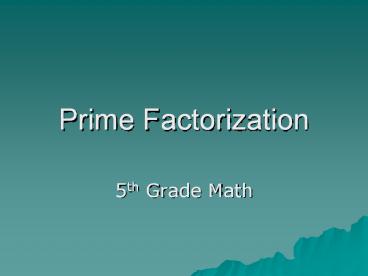Prime Factorization - PowerPoint PPT Presentation
1 / 13
Title:
Prime Factorization
Description:
Prime Factorization 5th Grade Math Prime Factorization Of a Number A prime number is a counting number that only has two factors, itself and one. – PowerPoint PPT presentation
Number of Views:459
Avg rating:3.0/5.0
Title: Prime Factorization
1
Prime Factorization
- 5th Grade Math
2
Prime Factorization Of a Number
- A prime number is a counting number that only has
two factors, itself and one. Counting numbers
which have more than two factors (such as six,
whose factors are 1, 2, 3 and 6), are said to be
composite numbers. When a composite number is
written as a product of all of its prime factors,
we have the prime factorization of the number. - There are several different methods in which can
be utilized for the prime factorization of a
number.
3
Using Division
- Prime factors can be found using division.
- Keep dividing until you have all prime numbers.
The prime factors of 78 are 2, 3, 13.
4
Remember the Divisibility Rules
- If the last digit is even, the number is
divisible by 2. - If the last digit is a 5 or a 0, the number is
divisible by 5. - If the number ends in 0, it is divisible by 10.
- If the sum of the digits is divisible by 3, the
number is also. - If the last two digits form a number divisible by
4, the number is also.
5
More divisibility rules
- If the number is divisible by both 3 and 2, it is
also divisible by 6. - Take the last digit, double it, and subtract it
from the rest of the number if the answer is
divisible by 7 (including 0), then the number is
also. - If the last three digits form a number divisible
by 8, then the whole number is also divisible by
8. - If the sum of the digits is divisible by 9, the
number is also.
6
- Using the Factor Tree
- 78
- / \
- / \
- 2 x 39
- / / \
- / / \
- 2 x 3 x 13
7
Exponents
- 72
- / \
- 8 x 9
- / \ / \
- 2 x 4 x 3 x 3
- / / \ \ \
- 2 x 2 x 2 x 3 x 3
- Another key idea in writing the prime
factorization of a number is an understanding of
exponents. An exponent tells how many times the
base is used as a factor. - 72 23 x 32
8
Lets Try a Factor Tree!
- 84
- / \
- 2 x 42
- / / \
- 2 x 2 x 21
- / / / \
- 2 x 2 3 x 7
- What is the final factorization?
- 22 x 3 x 7 84
9
Factor Trees do not look the same for the same
number, but the final answer is the same.
- 72
- / \
- 8 x 9
- / \ / \
- 2 x 4 x 3 x 3
- / \
- 2 x 2 x 2 x 3 x 3
- 72
- / \
- 2 x 36
- / / \
- 2 x 2 x 18
- / / / \
- 2 x 2 x 2 x 9
- / / / / \
- 2 x 2 x 2 x 3 x 3
10
Greatest Common Factors
- One method to find greatest common factors is to
list the factors of each number. The largest
number is the greatest common factor. - Lets find the factors of 72 and 84.
- 72
- 1, 2, 3, 4, 6, 8, 9, 12, 18, 24, 36, 72
- 84
- 1, 2, 3, 4, 6, 12, 14, 21, 28, 42, 84
11
Prime Factorization is helpful for finding
greatest common factors.
- 72
- / \
- 8 x 9
- / \ / \
- 2 x 4 x 3 x 3
- / \
- 2 x 2 x 2 x 3 x 3
- Take the common prime factors of each number and
multiply to find the greatest common factor.
- 84
- / \
- 2 x 42
- / / \
- 2 x 2 x 21
- / / / \
- 2 x 2 3 x 7
- 2 x 2 x 3 12
12
Resources
- Brain Pop Prime Factors
- Brain Pop - Prime Numbers
- Brain Pop - Exponents
13
Standards
- Checks for Understanding
- 0506.2.2 Use the prime factorization of two
whole numbers to determine the greatest common
factor and the least common multiple. - 0506.2.2 Use the prime factorization of two
whole numbers to determine the greatest common
factor and the least common multiple. - 0506.2.4 Use divisibility rules to factor
numbers. - 0506.2.10 Use exponential notation to represent
repeated multiplication of whole numbers. - Grade Level Expectations
- GLE 0506.2.2 Write natural numbers (to 50) as
a product of prime factors and understand that
this is unique (apart from order).































